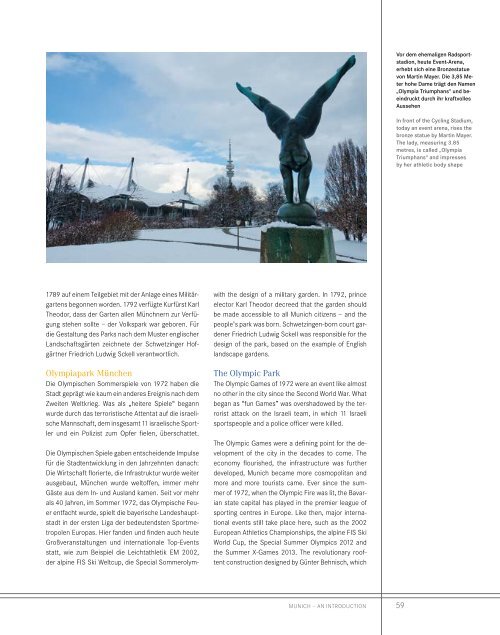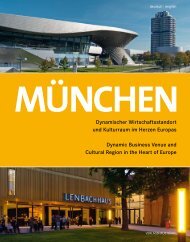München - Dynamischer Wirtschaftsstandort und Kulturraum im Herzen Europas
You also want an ePaper? Increase the reach of your titles
YUMPU automatically turns print PDFs into web optimized ePapers that Google loves.
Vor dem ehemaligen Radsportstadion,<br />
heute Event-Arena,<br />
erhebt sich eine Bronzestatue<br />
von Martin Mayer. Die 3,85 Meter<br />
hohe Dame trägt den Namen<br />
„Olympia Triumphans“ <strong>und</strong> beeindruckt<br />
durch ihr kraftvolles<br />
Aussehen<br />
In front of the Cycling Stadium,<br />
today an event arena, rises the<br />
bronze statue by Martin Mayer.<br />
The lady, measuring 3.85<br />
metres, is called „Olympia<br />
Triumphans“ and <strong>im</strong>presses<br />
by her athletic body shape<br />
1789 auf einem Teilgebiet mit der Anlage eines Militärgartens<br />
begonnen worden. 1792 verfügte Kurfürst Karl<br />
Theodor, dass der Garten allen Münchnern zur Verfügung<br />
stehen sollte – der Volkspark war geboren. Für<br />
die Gestaltung des Parks nach dem Muster englischer<br />
Landschaftsgärten zeichnete der Schwetzinger Hofgärtner<br />
Friedrich Ludwig Sckell verantwortlich.<br />
Olympiapark <strong>München</strong><br />
Die Olympischen Sommerspiele von 1972 haben die<br />
Stadt geprägt wie kaum ein anderes Ereignis nach dem<br />
Zweiten Weltkrieg. Was als „heitere Spiele“ begann<br />
wurde durch das terroristische Attentat auf die israelische<br />
Mannschaft, dem insgesamt 11 israelische Sportler<br />
<strong>und</strong> ein Polizist zum Opfer fielen, überschattet.<br />
Die Olympischen Spiele gaben entscheidende Impulse<br />
für die Stadtentwicklung in den Jahrzehnten danach:<br />
Die Wirtschaft florierte, die Infrastruktur wurde weiter<br />
ausgebaut, <strong>München</strong> wurde weltoffen, <strong>im</strong>mer mehr<br />
Gäste aus dem In- <strong>und</strong> Ausland kamen. Seit vor mehr<br />
als 40 Jahren, <strong>im</strong> Sommer 1972, das Olympische Feuer<br />
entfacht wurde, spielt die bayerische Landeshauptstadt<br />
in der ersten Liga der bedeutendsten Sportmetropolen<br />
<strong>Europas</strong>. Hier fanden <strong>und</strong> finden auch heute<br />
Großveranstaltungen <strong>und</strong> internationale Top-Events<br />
statt, wie zum Beispiel die Leichtathletik EM 2002,<br />
der alpine FIS Ski Weltcup, die Special Sommerolym-<br />
with the design of a military garden. In 1792, prince<br />
elector Karl Theodor decreed that the garden should<br />
be made accessible to all Munich citizens – and the<br />
people’s park was born. Schwetzingen-born court gardener<br />
Friedrich Ludwig Sckell was responsible for the<br />
design of the park, based on the example of English<br />
landscape gardens.<br />
The Olympic Park<br />
The Olympic Games of 1972 were an event like almost<br />
no other in the city since the Second World War. What<br />
began as “fun Games” was overshadowed by the terrorist<br />
attack on the Israeli team, in which 11 Israeli<br />
sportspeople and a police officer were killed.<br />
The Olympic Games were a defining point for the development<br />
of the city in the decades to come. The<br />
economy flourished, the infrastructure was further<br />
developed, Munich became more cosmopolitan and<br />
more and more tourists came. Ever since the summer<br />
of 1972, when the Olympic Fire was lit, the Bavarian<br />
state capital has played in the premier league of<br />
sporting centres in Europe. Like then, major international<br />
events still take place here, such as the 2002<br />
European Athletics Championships, the alpine FIS Ski<br />
World Cup, the Special Summer Olympics 2012 and<br />
the Summer X-Games 2013. The revolutionary rooftent<br />
construction designed by Günter Behnisch, which<br />
Munich – an introduction 59




